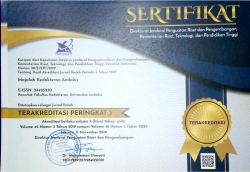Variasi Genetik Region Binding Motif (RBM) Gen Spike SARS CoV-2 Pada Isolat Lokal Sumatera Barat
Abstract
Tujuan: untuk mengetahui sebaran titik mutasi pada sekuens Region Binding Motif (RBM) gen Spike SARS CoV-2 yang berasal dari isolat lokal Sumatera Barat. Metode: studi deskriptif eksploratif menggunakan koleksi spesimen laboratorium Pusat Diagnostik dan Riset Penyakit Infeksi (PDRPI) Fakultas Kedokteran Universitas Andalas yang diisolasi, dilanjutkan tahap sequencing dan analisa data secara bioinformatika. Hasil: terdapat tiga titik mutasi non-synonimous disepanjang RBM gen Spike SARS Co-2. Kesimpulan: mutasi Asn439Lys merupakan titik mutasi tersering pada RBM gen Spike sebesar 11% diikuti Ser477Gly dan Thr478Ile masing-masingnya 3% dan 1%.
Keywords
Full Text:
PDFReferences
World Health Organization. WHO Corona Virus (COVID19) Dashboard [Internet]. 2021. Available from: https://covid19.who.int/table
Mizumoto K, Kagaya K, Zarebski A, Chowell G. Estimating the asymptomatic proportion of coronavirus disease 2019 (COVID-19) cases on board the Diamond Princess cruise ship, Yokohama, Japan, 2020. Eurosurveillance. 2020;25(10):2000180.
Van Dijk EL, Jaszczyszyn Y, Thermes C. Library preparation methods for next-generation sequencing: tone down the bias. Exp Cell Res. 2014;322(1):12–20.
Hu X, Yuan J, Shi Y, Lu J, Liu B, Li Z, et al. pIRS: Profile-based Illumina pair-end reads simulator. Bioinformatics. 2012;28(11):1533–5.
Proprietary I. Illumina RNA Prep with Enrichment, (L) Tagmentation Checklist. 2020;(August):1–5.
Gibson NJ. The use of real-time PCR methods in DNA sequence variation analysis. Clin Chim Acta. 2006;363(1–2):32–47.
Bokulich NA, Subramanian S, Faith JJ, Gevers D, Gordon JI, Knight R, et al. Quality-filtering vastly improves diversity estimates from Illumina amplicon sequencing. Nat Methods. 2013;10(1):57–9.
Mercatelli D, Giorgi FM. Geographic and genomic distribution of SARS-CoV-2 mutations. Front Microbiol. 2020;11:1800.
Du L, He Y, Zhou Y, Liu S, Zheng B-J, Jiang S. The spike protein of SARS-CoV—a target for vaccine and therapeutic development. Nat Rev Microbiol. 2009;7(3):226–36.
Focosi D, Maggi F. Neutralising antibody escape of SARS‐CoV‐2 spike protein: Risk assessment for antibody‐based Covid‐19 therapeutics and vaccines. Rev Med Virol. 2021;
Acevedo ML, Alonso-Palomares L, Bustamante A, Gaggero A, Paredes F, Cortés CP, et al. Infectivity and immune escape of the new SARS-CoV-2 variant of interest Lambda. medRxiv. 2021;
Harvey WT, Carabelli AM, Jackson B, Gupta RK, Thomson EC, Harrison EM, et al. SARS-CoV-2 variants, spike mutations and immune escape. Nat Rev Microbiol. 2021;19(7):409–24.
Koyama T, Platt D, Parida L. Variant analysis of SARS-CoV-2 genomes. Bull World Health Organ. 2020;98(7):495.
Zekri ARN, Easa Amer K, Hafez MM, Hassan ZK, Ahmed OS, Soliman HK, et al. Genomic characterization of SARS-CoV-2 in Egypt. J Adv Res [Internet]. 2021;30(xxxx):123–32. Available from: https://doi.org/10.1016/j.jare.2020.11.012
Duffy S. Why are RNA virus mutation rates so damn high? PLoS Biol. 2018;16(8):e3000003.
Zhou W, Xu C, Wang P, Luo M, Xu Z, Cheng R, et al. N439K variant in spike protein may alter the infection efficiency and antigenicity of SARS-CoV-2 based on molecular dynamics simulation. BioRxiv. 2020;
Thomson EC, Rosen LE, Shepherd JG, Spreafico R, da Silva Filipe A, Wojcechowskyj JA, et al. Circulating SARS-CoV-2 spike N439K variants maintain fitness while evading antibody-mediated immunity. Cell. 2021;184(5):1171–87.
Wu J, Zhang L, Zhang Y, Wang H, Ding R, Nie J, et al. The Antigenicity of Epidemic SARS-CoV-2 Variants in the United Kingdom. Front Immunol. 2021;12:2205.





















